- Afrikaans
- Albanian
- Amharic
- Arabic
- Armenian
- Azerbaijani
- Basque
- Belarusian
- Bengali
- Bosnian
- Bulgarian
- Catalan
- Cebuano
- Corsican
- Croatian
- Czech
- Danish
- Dutch
- English
- Esperanto
- Estonian
- Finnish
- French
- Frisian
- Galician
- Georgian
- German
- Greek
- Gujarati
- Haitian Creole
- hausa
- hawaiian
- Hebrew
- Hindi
- Miao
- Hungarian
- Icelandic
- igbo
- Indonesian
- irish
- Italian
- Japanese
- Javanese
- Kannada
- kazakh
- Khmer
- Rwandese
- Korean
- Kurdish
- Kyrgyz
- Lao
- Latin
- Latvian
- Lithuanian
- Luxembourgish
- Macedonian
- Malgashi
- Malay
- Malayalam
- Maltese
- Maori
- Marathi
- Mongolian
- Myanmar
- Nepali
- Norwegian
- Norwegian
- Occitan
- Pashto
- Persian
- Polish
- Portuguese
- Punjabi
- Romanian
- Russian
- Samoan
- Scottish Gaelic
- Serbian
- Sesotho
- Shona
- Sindhi
- Sinhala
- Slovak
- Slovenian
- Somali
- Spanish
- Sundanese
- Swahili
- Swedish
- Tagalog
- Tajik
- Tamil
- Tatar
- Telugu
- Thai
- Turkish
- Turkmen
- Ukrainian
- Urdu
- Uighur
- Uzbek
- Vietnamese
- Welsh
- Bantu
- Yiddish
- Yoruba
- Zulu
Petroleum Tubing Joint Connections for Efficient Oil Extraction and Production Techniques
Understanding Petroleum Tubing Couplings An Essential Component in Oil and Gas Operations
In the oil and gas industry, efficiency, safety, and reliability are paramount. One of the critical components that play a vital role in ensuring these factors are petroleum tubing couplings. These couplings are essential for connecting sections of tubing in the drilling and production of oil and gas. Understanding their design, function, and applications can greatly enhance operational effectiveness in petroleum extraction.
What are Petroleum Tubing Couplings?
Petroleum tubing couplings are mechanical devices designed to connect lengths of tubing. Tubing itself is used to transport oil and gas from the wellhead to the surface and into processing facilities. Without proper couplings, the strength and integrity of the tubing system would be compromised. Couplings can be constructed from various materials, with steel being the most common due to its strength and resistance to corrosion—an important characteristic given the harsh environments in which they operate.
Design and Functionality
The design of petroleum tubing couplings is specifically tailored to meet the demands of various drilling conditions. These couplings are typically threaded at both ends, allowing for secure connections between adjacent tubing sections. The threads create a tight seal, which is crucial for preventing leaks of pressurized fluids. Additionally, couplings may vary in length and weight based on the application and required load-bearing capacity.
A crucial aspect of their functionality is their ability to withstand the high pressures and temperatures found in oil and gas wells. Couplings must be able to handle dynamic forces during drilling operations as well as static pressures when the well is producing oil or gas. Consequently, they undergo rigorous testing to ensure they meet industry standards and can operate safely under extreme conditions.
Types of Couplings
There are several types of petroleum tubing couplings, each designed for specific applications. The most common include
petroleum tubing coupling

1. API Couplings These meet the American Petroleum Institute (API) specifications, ensuring standardized quality and performance across the industry. API couplings are particularly valued for their reliability in various operational conditions.
2. Premium Couplings These are engineered for high-performance applications and often feature enhanced sealing and torque capabilities. Premium couplings are used in more demanding environments where standard couplings may fail.
3. Non-API Couplings Some companies manufacture couplings that do not strictly adhere to API specifications but may offer unique features or cost savings for specific applications. These couplings should still provide adequate performance for their intended use.
Importance in Oil and Gas Operations
The significance of petroleum tubing couplings cannot be overstated. In oil and gas operations, any failure in the tubing system can lead to costly downtime, loss of resources, and potential safety hazards. Reliable couplings ensure continuous production and minimize the risk of accidents related to leaks or equipment failures.
Furthermore, as oil and gas extraction techniques evolve, the demand for high-quality couplings will only increase. Developments in horizontal and deep-water drilling require couplings that can perform under unprecedented conditions. Companies that invest in quality couplings stand to gain a competitive edge in the market by reducing operational risks and enhancing productivity.
Conclusion
In conclusion, petroleum tubing couplings are a vital element in the infrastructure of the oil and gas industry. Their design, material, and specific application requirements contribute to the overall efficiency and safety of drilling and production operations. As the industry continues to evolve, so too will the technologies and standards associated with these critical components, highlighting the need for continued innovation and quality assurance in petroleum tubing couplings. Through diligence and investment in reliable couplings, companies can enhance their operational success and contribute to a more sustainable energy future.
-
Tubing Pup Joints: Essential Components for Oil and Gas OperationsNewsJul.10,2025
-
Pup Joints: Essential Components for Reliable Drilling OperationsNewsJul.10,2025
-
Pipe Couplings: Connecting Your World EfficientlyNewsJul.10,2025
-
Mastering Oilfield Operations with Quality Tubing and CasingNewsJul.10,2025
-
High-Quality Casing Couplings for Every NeedNewsJul.10,2025
-
Boost Your Drilling Efficiency with Premium Crossover Tools & Seating NipplesNewsJul.10,2025







